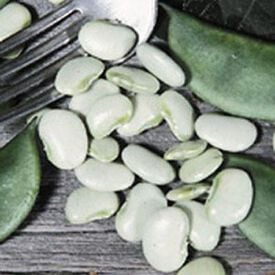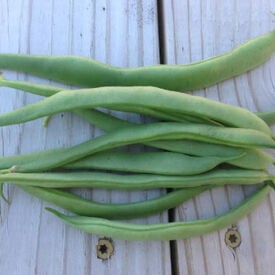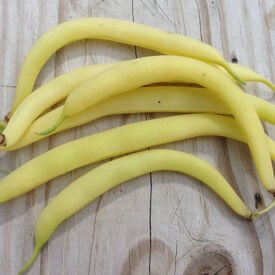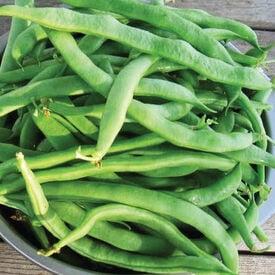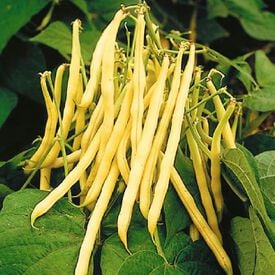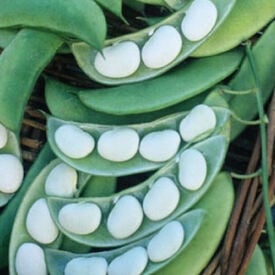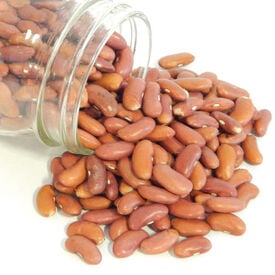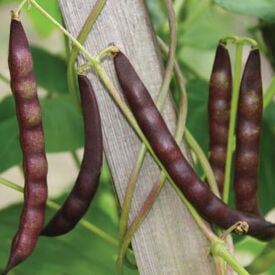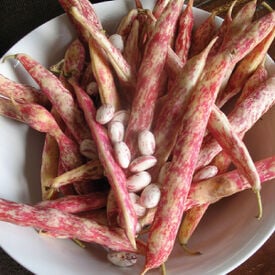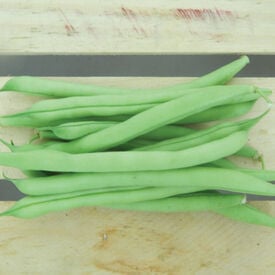Calypso bean seeds, also known as "Yin Yang" beans for their striking black-and-white pattern, produce compact bush plants that typically grow 15 to 20 inches tall. These heirloom beans mature in about 70 to 90 days and are cherished for their creamy texture and mild, earthy flavor, making them ideal for soups, stews, and salads. Calypso beans are easy to grow, thriving in full sun and well-drained soil, and they offer good drought tolerance. Their unique appearance and reliable performance make them a favorite among gardeners and heirloom seed enthusiasts alike.
Bronco bean seeds produce vigorous bush plants that grow to about 18 to 24 inches tall and mature in approximately 55 to 60 days, making them a fast-growing option for gardeners. This variety is a high-yielding snap bean, known for its straight, slender, medium-green pods that are about 5 to 6 inches long. Bronco beans are tender, flavorful, and stringless, making them ideal for fresh eating, steaming, or freezing. They are also resistant to common bean diseases such as rust and mosaic virus, and perform well in a range of growing conditions with full sun and well-drained soil.
Jacob’s Cattle bean seeds grow into sturdy bush plants that reach about 18 to 24 inches in height and are prized for their early maturity, typically reaching harvest in 80 to 100 days. This heirloom variety, also known as Trout or Dalmatian bean, produces oval-shaped seeds with a distinctive white and deep maroon mottled pattern. Known for their rich, hearty flavor and meaty texture, Jacob’s Cattle beans hold up well during long cooking, making them excellent for baked beans, soups, and chili. They thrive in full sun and well-drained soil, offering dependable yields and good drought tolerance.
Dapple Grey bean seeds grow into compact bush plants reaching about 18 to 24 inches in height and typically mature in 85 to 95 days. This heirloom dry bean variety is known for its eye-catching gray seeds mottled with darker streaks, giving it a distinctive “dappled” appearance. Dapple Grey beans have a rich, hearty flavor and a firm texture, making them a popular choice for soups, stews, and chili. Easy to grow and well-adapted to a variety of climates, these beans thrive in full sun and well-drained soil, offering reliable yields and excellent storage quality.
Soldier bean seeds produce a traditional New England heirloom dry bean known for its creamy white color and distinctive reddish-brown marking near the hilum that resembles a toy soldier—hence the name. These bush-type plants are hardy and compact, typically reaching maturity in about 85 to 95 days, and they yield reliably even in cooler climates. Soldier beans are especially prized for their mild, earthy flavor and smooth texture, making them a favorite for baked beans, soups, and stews. Their excellent storage qualities and historical significance have kept them a staple in regional cooking for generations. Easy to grow and harvest, Soldier beans are a dependable and flavorful addition to any garden.
Bountiful bean seeds produce one of the earliest and most reliable bush snap beans, known for their exceptional productivity and tender, stringless pods. Introduced in the late 19th century, this heirloom variety remains popular for its rich flavor, crisp texture, and consistent performance in a wide range of climates. The compact, bushy plants grow about 12 to 18 inches tall and do not require staking, making them perfect for small gardens or raised beds. Bountiful beans are easy to harvest and ideal for fresh eating, canning, or freezing. Their early maturity and dependable yields make them a favorite among home gardeners and market growers alike.
Jacob’s Cattle Gold bean seeds produce robust bush plants that grow to about 18 to 24 inches tall and mature in approximately 85 to 95 days. A golden-hued variant of the traditional Jacob’s Cattle bean, this heirloom variety features beautiful tan seeds with maroon speckles and splashes. Renowned for their creamy texture and rich, slightly sweet flavor, Jacob’s Cattle Gold beans are ideal for baking, soups, and slow-cooked dishes. They perform well in a range of garden soils, thrive in full sun, and offer consistent yields, making them a favorite among home gardeners and heirloom collectors.
Kenearly Yellow Eye bean seeds produce bush-type plants that grow to about 18 to 24 inches tall and are known for their high yields and disease resistance. These heirloom beans mature in approximately 85 to 95 days and are distinguished by their creamy white seeds with a distinct yellow "eye" marking. Valued for their mild, buttery flavor and smooth texture, Kenearly Yellow Eye beans are excellent for soups, stews, and baked dishes. They thrive in well-drained soil and full sun, and their compact growth habit makes them easy to harvest and ideal for small garden spaces.
The Eastland bean, scientifically known as Phaseolus vulgaris 'Eastland,' is a popular variety of bush bean that hails from the United States. It is highly esteemed for its exceptional taste and ease of cultivation. Eastland beans belong to the family Fabaceae and are a warm-season crop commonly grown in gardens and small-scale farms. In terms of taste, Eastland beans are celebrated for their tender, crisp texture and rich, earthy flavor. They are a delight to eat both raw and cooked. The pods of Eastland beans are of medium size, typically measuring around 4-5 inches in length. The plants themselves are compact and bushy, making them suitable for smaller gardens and spaces. These beans have a relatively short maturity period, typically taking around 70-75 days from planting to harvest. The beans are known for their vibrant green color, making them visually appealing as well. Eastland beans are generally resistant to common bean diseases such as bean mosaic virus and rust. They are known to provide a good yield per acre, often ranging from 800 to 1,200 pounds of beans per acre, depending on growing conditions and care. Proper spacing is crucial for their growth, with plants typically spaced 3-4 inches apart in rows that are about 18-24 inches apart. These beans thrive in well-drained soil with full sun exposure and require regular watering to maintain consistent moisture levels in the soil. Overall, Eastland beans are a favorite among gardeners and farmers for their taste, disease resistance, and relatively quick harvest time.
Greencrop beans are a classic heirloom variety renowned for their distinctive features and reliable performance. Originating in the early 20th century, this variety has been favored by gardeners for its robust growth and high productivity. Greencrop beans are characterized by their striking green color, smooth texture, and uniform shape. The plants are typically bush-type, reaching a height of about 18 to 24 inches, which makes them suitable for smaller garden spaces and easier to manage without extensive staking. The beans themselves are known for their crisp and tender texture, combined with a mildly sweet and fresh flavor that enhances a variety of dishes. Harvesting is best done when the pods are young and firm, usually in mid to late summer, to ensure optimal taste and texture. Greencrop beans are valued for their high yield and resistance to common diseases, making them a dependable choice for both home gardeners and market growers. With their appealing flavor, compact growth habit, and consistent performance, Greencrop beans remain a popular and practical selection for vegetable gardens.
Cherokee Wax beans, also known as Cherokee Yellow Wax beans, are a popular variety of bush beans cherished for their vibrant appearance and delicious flavor. These beans are believed to have originated from the Native American Cherokee tribe, hence their name. Cherokee Wax beans are a warm-season vegetable that thrives in various climates, making them a favorite among home gardeners and commercial growers alike. Cherokee Wax beans are known for their exceptional taste, boasting a mild, slightly sweet flavor with a tender and crisp texture. They are a type of bush bean, which means they grow as compact, bushy plants that don't require support structures. The pods of Cherokee Wax beans typically measure around 5 to 6 inches in length and have a bright yellow color. These beans have a relatively short time to maturity, usually taking about 50-55 days from planting to harvest. They are highly productive, yielding an impressive quantity of beans per 10-foot row. In terms of growing conditions, Cherokee Wax beans thrive in well-draining soil that receives full sun exposure. They require spacing of about 3-4 inches between plants and should be sown in rows that are 18-24 inches apart. Cherokee Wax beans are generally disease-resistant, with some varieties exhibiting resistance to common bean diseases like rust and mosaic virus. With proper care and regular harvesting, these beans can provide a bountiful and delicious addition to your garden or dinner table.
The Kentucky Wonder 125 bean is a wonderful bush bean that is above the others! Kentucky Wonder 125 Bush Bean matures early than most bush beans and produces beans in clusters over a long season. The bush beans’ meaty, medium-green pods are 8 inches and packed with delicious, extra-tasty bean seeds.
The Pencil Pod Black Wax bean is a highly productive and long standing bush bean. Also known as 'Eastern Black Wax', these beans are bushy, vigorous, and resistant to rust and mosaic virus. The pods are golden color and grow to 5-7" long. A great all-purpose type, that is great fresh, canned, or frozen. As the name hints, the seeds are black.
The Burpee Improved Bush Lime bean plants produce large pods, high yields, and perfectly shaped beans. Burpee Improved beans are both larger and thicker than normal lima beans. The growth is even more vigorous, with heavier foliage. The plants are uniformly upright.
The Light Red Kidney Bean is a popular kidney bean that has mild bean flavor! Excellent for chili, bean salads, and soups. Exceptional culinary quality, with silky texture and thin skin. Plants grow to medium size that are sturdy and widely adapted. Produce well anywhere in the United States.
The Black Turtle Soup bean is very popular Latin favorite, that is also great in Cajun and Creole dishes. A tasty variety that grows upright with black beans inside the pod. Tall bush that keeps the bean pods off the ground.
The Vermont Cranberry Shell bean is an incredible bean variety that can be used as a snap, shell or dry bean. Cranberry Shell stores exceptionally well. Maroon colored beans are decorated with darker red, cranberry markings. This variety dates back to the 1800s and is well-suited to short-season, cool summer climates.
Provider beans are a popular bush bean variety that has garnered attention for its reliable performance and ease of cultivation. Developed in the United States, Provider beans have a rich history dating back to the mid-20th century, when they were bred for both home gardens and commercial production. These beans are characterized by their compact growth habit, typically reaching about 18 to 24 inches in height, which makes them perfect for small spaces and easy to manage without staking. The pods are smooth and a vibrant green color, generally growing to about 5 to 6 inches long. Known for their excellent flavor and crisp texture, Provider beans are ideal for fresh eating, canning, or freezing. Harvesting is best done when the pods are young and firm, usually in mid to late summer, ensuring the best taste and quality. The plants are vigorous and produce high yields, demonstrating good resistance to common diseases. With their dependable growth, delightful flavor, and adaptability, Provider beans remain a favorite choice for both novice and experienced gardeners.








